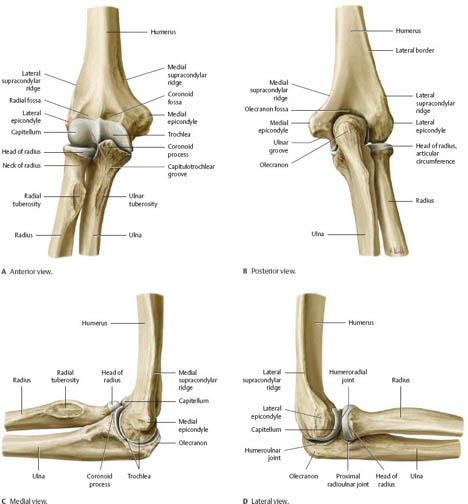Elbow Anatomy, Injuries, and Treatment
It is often difficult for patients to have all the information they need to understand the symptoms and challenges they are facing. It is helpful to consider elbow anatomy, injuries, and treatment for these conditions.
Injuries

The majority of injuries to the elbow are the result of trauma.
This can be a single traumatic event such as a high energy fall or from chronic repetitive overuse. The elbow is very sensitive to injury and does not tolerate prolonged immobilization. It typically can develop stiffness and loss of motion with prolonged immobilization. Therefore, our goal is to get it moving as soon as possible, even with very severe injuries.
- Fractures – These most often result from a traumatic force being placed on the elbow. This can be from a fall on an outstretched hand or directly landing on the elbow.
-
- Radial Head Fractures – These most often result from a fall on an outstretched hand. The majority of these fractures are treated with short term immobilization (a few days to 2 weeks) followed by early mobilization and physical therapy. A small percentage of these fractures require surgery to repair. This is only required if there is significant displacement.
- Olecranon Fractures – This is a fracture of the “tip” of the elbow and occurs from a direct blow to the elbow. These fractures almost always require surgery to repair.
- Dislocations – Elbow dislocations typically result from a fall on an outstretched hand that results in hyperextension of the elbow. Dislocations are typically treated with relocation under sedation followed by a couple of weeks of immobilization in a hinged brace. Mobilization is then started gradually increasing extension over a period of weeks. This is supervised by a physical therapist and your doctor. These injuries do very well and rarely require surgery
- Lateral and Medial Epicondylitis – These very common conditions are referred to as “Tennis Elbow” and “Golfer’s Elbow”. They are the result of chronic repetitive injury to the extensor or flexor tendons of the wrist that attach on the lateral(outside) or medial(inside) of the elbow. Patients present with complaints of pain with lifting weighted objects or with extending or flexing the wrist. Historically, physicians have given steroid injections for this problem, but we know from the orthopedic literature that these injections provide no long term benefit and can actually harm the tendon and cause long term problems. When this problem is persistent, surgery was recommended to “repair” the tendon. Currently, there are better non-operative options.
 Distal Biceps Tendon Rupture – The biceps tendon attaches to the radial tuberosity just distal to the elbow joint. The biceps muscle’s primary responsibility supination of the forearm (turning palm up), but it is also a secondary flexor of the elbow. The brachialis is the primary flexor of the elbow. A distal biceps rupture results from forced extension of an elbow from a nearly extended elbow against the force of a fully contracted biceps. Patients will usually feel a “pop” and develop bruising on the medial forearm. These tears require surgical repair in order to heal. They can be treated non-surgically but will result in significant supination and elbow flexion weakness. Please click on the following link to see a surgical video of Dr. Jones repairing a distal biceps. https://www.youtube.com/watch?v=mvTzy8Y6JiQ This video has been viewed by thousands of surgeons in order to learn Dr. Jones’ technique. It was uploaded to an orthopedic surgeon continuing education site, Orthobullets, and surgeons who watched it received continuing education credits.
Distal Biceps Tendon Rupture – The biceps tendon attaches to the radial tuberosity just distal to the elbow joint. The biceps muscle’s primary responsibility supination of the forearm (turning palm up), but it is also a secondary flexor of the elbow. The brachialis is the primary flexor of the elbow. A distal biceps rupture results from forced extension of an elbow from a nearly extended elbow against the force of a fully contracted biceps. Patients will usually feel a “pop” and develop bruising on the medial forearm. These tears require surgical repair in order to heal. They can be treated non-surgically but will result in significant supination and elbow flexion weakness. Please click on the following link to see a surgical video of Dr. Jones repairing a distal biceps. https://www.youtube.com/watch?v=mvTzy8Y6JiQ This video has been viewed by thousands of surgeons in order to learn Dr. Jones’ technique. It was uploaded to an orthopedic surgeon continuing education site, Orthobullets, and surgeons who watched it received continuing education credits.
- Arthritis and Loose Bodies – Patients can develop arthritis or loose bodies in the elbow after suffering a traumatic injury (fracture or dislocation). Arthritic elbows are rarely symptomatic unless they develop significant loss of motion. However, they can develop loose bodies that float around the elbow and intermittently cause locking and pain. This is the primary indication for elbow arthroscopy. Arthroscopy is a minimally invasive procedure that involves several 5mm incisions that allows the surgeon to insert a viewing scope and instruments into the joint. The scope allows the surgeon to visualize the joint, clean up arthritis, and remove the loose bodies. This is a fairly quick procedure and the recovery is predictably quick.
There are certainly many other conditions that can affect the elbow, but this summary covers the most common that initiates patients to seek an orthopaedic surgeon.
If you are looking for more information on elbow anatomy, injuries, and treatment, you may contact Dr. Jones’ office and request a consultation.
